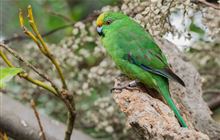Predator control operation to protect kākāriki karaka
Archived content: This media release was accurate on the date of publication.
Introduction
An aerial 1080 predator control operation will protect a stronghold for critically endangered kākāriki karaka/orange-fronted parakeet near Arthur’s Pass in early-2022.Date: 21 January 2022
Covering 53,765 ha in Arthur’s Pass National Park and Lake Sumner (Hoka Kura) Forest Park, the operation will safeguard not only kākāriki karaka, but also threatened species like great spotted kiwi/roroa, rock wren/pīwauwau and yellowhead/mohua. It’s scheduled to run after 24 January, with the exact timing dependant on the weather.
Our monitoring has shown high numbers of predators in some parts of the operational area. Monitoring tunnels are showing rat tracking rates of up to 21% on some monitoring lines in valleys such as the Poulter.
For areas with kākāriki karaka, the target is to have less than 2% rat tracking in monitoring tunnels. It is expected this operation will bring predator numbers back down to those levels.
About the size of a budgie, kākāriki karaka are a taonga species. About 360 remain in the wild, making them our rarest mainland forest bird, and their main stronghold is in the North Canterbury valleys within the operational area.
DOC North Canterbury Operations Manager Leeann Ellis says kākāriki karaka are especially vulnerable to predators at this time of year as they nest in holes in trees, which makes them easy targets.
“We appreciate this is a busy time of year for visitors to the National Park, but with kākāriki karaka breeding season beginning, this control work cannot wait.”
The operation area takes in public tracks including the Edwards Hut Track, Hawdon Hut Track, Woolshed Hill Track, Andrews Valley Track, Binser Valley Track, Poulter River Track, Minchin Stream Route and Minchin Pass Route.
Access to some tracks will be restricted while the operation is carried out. Signage will be placed at key access points.
“People who were planning to visit the area in late-January should check the DOC website for the latest information and should consider the range of nearby tracks, huts and campsites that are outside the operation area,” Leann Ellis says.
“Those planning to camp at the Hawdon Shelter could instead stay at Klondyke Corner, while those wanting an overnight tramp could consider visiting Carrington Hut, tackle the Cass-Lagoon Saddle Track, or traverse the Mingha-Deception, depending on their experience level.
“If people are in the operation area, they should not touch bait pellets and should keep a close eye on children.”
The operation begins with a 'pre-feed' of sandy-coloured non-toxic cereal pellets. This accustoms the pests to the pellets as food. About a week later, depending on the weather, a second operation will sow green-coloured pellets that include 1080.
The timing of the operation will be weather dependent and people are advised to check the DOC website for the latest information if they are planning a visit in the area.
The operation is part of Tiakina Ngā Manu, DOC’s national programme to protect taonga native species and forests through predator control.
Contact
For media enquiries contact:
Email: media@doc.govt.nz

